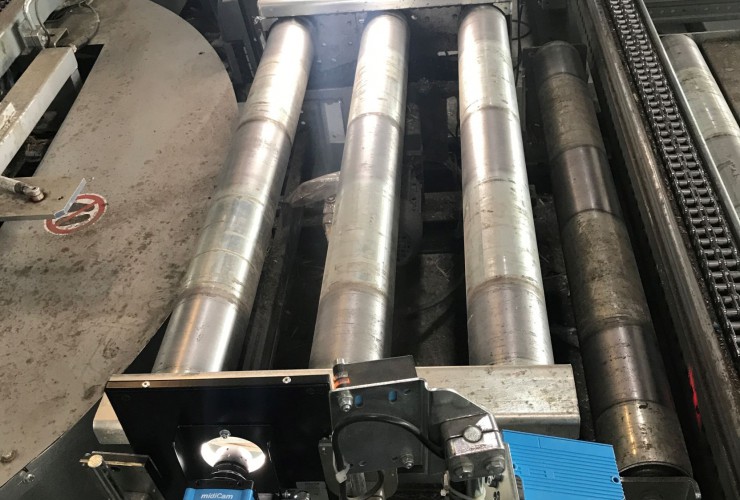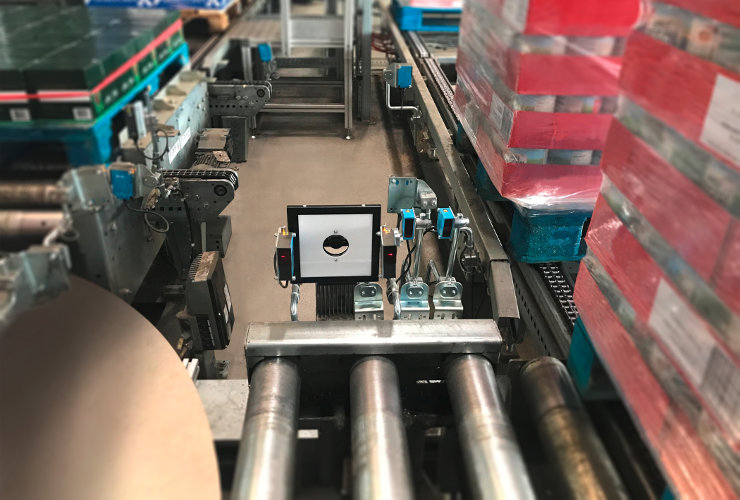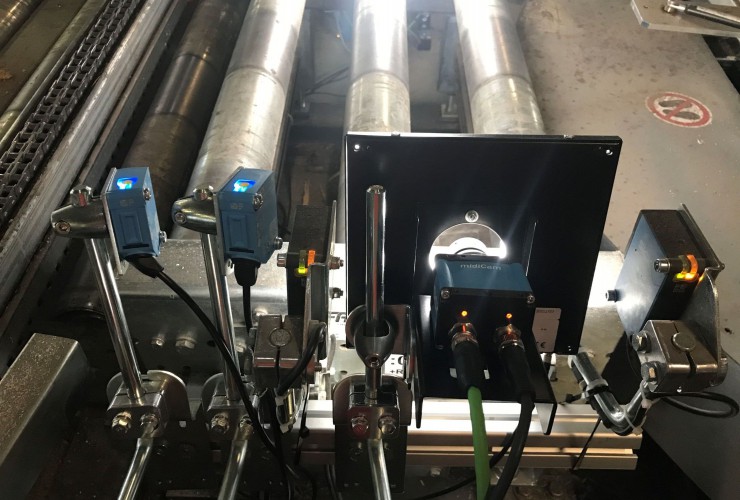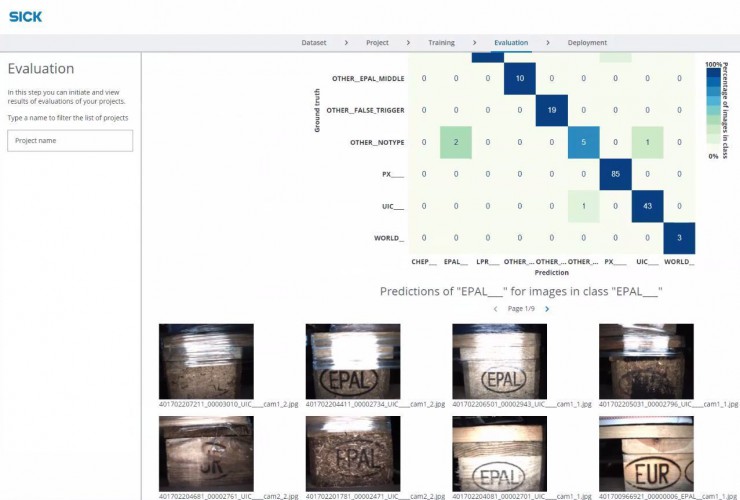IFOY Schirmherrschaft
IFOY Träger
IFOY Partner
PACS (PAllet Classification System)
SICK
IFOY-Kategorie
Special of the Year
Zusammenfassung
Einer unserer Kunden stand vor dem Problem, dass seine Mitarbeiter im Wareneingang manuell ermitteln mussten, ob eintreffende Paletten einem Palettenpool angehören und entsprechend bepfandet werden. Bislang handelte es sich dabei um eine Zusatzaufgabe im Wareneingang, die ressourcenintensiv und fehleranfällig war.
Mit der Deep Learning-basierten Palettenidentifikation PACS (PAllet Classification System) von SICK erhalten Kunden die Möglichkeit, auf Basis eines modularen Baukastens aus Hardware und Software einen bislang aufwändigen und manuellen Prozess zu automatisieren.
Der Baukasten basiert auf SICK Appspace und dStudio. Appspace ist ein innovativer Ansatz zur Realisierung von leistungsfähigen Apps auf SICK Sensoren, dStudio ist ein webbasiertes Tool zur Klassifikation von Bildern auf Basis künstlicher neuronaler Netze, welche auf SICK Sensoren eingesetzt werden können. Der Baukasten kann auch für andere Aufgaben im Bereich der Bildverarbeitung genutzt werden.
Beschreibung
Das Deep Learning-basierte Palettenidentifikationssystem PACS von SICK wird zur automatisierten Erkennung von Palettentypen eingesetzt. Die automatisierte Erkennung vereinfacht den Prozess der automatischen Bepfandung von verschiedenen Palettentypen und kann als kompaktes System mit geringem Platzbedarf an vielen Positionen integriert werden.
Die Hardware des Systems besteht aus einer oder mehreren Farbkameras zur Bildaufnahme, einer Lichtschrankenanordnung zur Triggerung, sowie einem Controller zur Verarbeitung der Daten und zur Ausführung des trainierten neuronalen Netzwerks.
Die Softwaretools SICK Appspace und dStudio ermöglichen Bildaufzeichnung, Training, Klassifizierung und die Ausführung des trainierten Netzwerks auch ohne tiefergehende Kenntnisse zu Programmierung oder maschinellem Lernen. Optional können weitere SICK Sensoren eingebunden werden, die zusätzliche Aufgaben übernehmen können.
Bewerbungsdaten
Innovation
Anders als bei herkömmlichen Bildverarbeitungslösungen, erfordert der Einsatz von Deep-Learning-Technologie in der SICK-Lösung keine detaillierten Programmierkenntnisse, da das System aus konkreten Beispielen lernt. Dadurch konnte SICK die Palettenidentifikation für den Kunden vergleichsweise einfach gestalten. Wo die Verwendung von trainierten neuronalen Netzwerken normalerweise tiefgreifende Kenntnisse im Bereich des maschinellen Lernens erfordert, hat SICK mit dStudio eine Trainingssoftware entwickelt, die einen geführten Prozessablauf beinhaltet. So konnte die Vielzahl von Einstellmöglichkeiten herkömmlicher Lösungen auf ein Minimum reduziert werden. Diese Vereinfachung ermöglicht es den Anwendern, sich auf ihre konkrete Applikation zu konzentrieren – und nicht auf die Technologie.
Im Zusammenspiel mit SICK Appspace und SICK’s Know-How im Bereich der Sensorapplikationen wurde das Deep Learning-basierte Palettenidentifikationssystem entwickelt eine Komplettlösung mit höchstem Kundennutzen aus einer Hand.
Marktrelevanz
Kunden aus verschiedenen Branchen verlieren jedes Jahr viel Geld, weil Pfandpaletten im Wareneingang fehlerhaft zugeordnet werden. Das SICK-System hilft ihnen dabei, Verluste zu vermeiden, Ressourcen zu sparen und ihre Prozessqualität signifikant zu erhöhen. Ein bislang ressourcenintensiver und fehleranfälliger manueller Prozess kann auf diese Weise automatisiert werden. Höhere Zuverlässigkeit, gesteigerte Effizienz und Transparenz sind nur einige der Vorteile, die durch die Palettenidentifikation von SICK gewährleistet werden.
Mit dieser innovativen Lösung können Kunden aus allen Industrien und über alle Branchen hinweg ihr Palettenhandling optimieren und ihre Ressourcen im Wareneingang entlasten.
Der Markt kann zudem aus Anwendersicht noch bedeutend größer sein: Die eingesetzten Technologien bieten sich nicht nur in der Anwendung für die Identifikation von Palettentypen an, sondern können in vielen anderen Bereichen ebenfalls signifikante Vorteile bieten.
Hauptvorteile für den Kunden
Die Vorteile der Deep Learning-basierten Palettenidentifikation PACS zeigen sich in der Erstellung, dem Einsatz und der Unterhaltung der Lösung.
Bei der Erstellung der Lösung kann im Vergleich zum Einsatz von herkömmlicher Bildverarbeitung Zeit und Komplexität eingespart werden. Durch die Verwendung von trainierten neuronalen Netzwerken ist es möglich, die Brandings der Palettentypen mit einer hohen Erfolgsquote zu erkennen, auch wenn die Qualität großen Abweichungen unterliegt. Diese Abweichungen werden im Trainingsprozess berücksichtigt, eingelernt und erhöhen so die Robustheit der Auswertung.
Der Einsatz der Lösung ermöglicht nicht nur eine Erhöhung der Effizienz und des Durchsatzes, sondern auch eine Steigerung der Prozessqualität und Nachverfolgbarkeit. Die Mitarbeiter werden entlastet und können sich auf Prozesse mit höherer Wertschöpfung konzentrieren.
Durch den platzsparenden Aufbau kann das System auch an engen Montagepositionen integriert werden. Die Verwendung von Standardsensorik macht Wartung und Unterhaltung des Systems sehr kostengünstig.
Technische Daten
IFOY Test
| Name | SICK, PACS (PAllet Classification System) |
| Category | Special of the Year |
| Date of Test | 17.-23. März 2022 |
Testbericht
Ist es eine Euro-, eine Chep-, eine UIC- oder vielleicht eine ganz andere Palette? Falsche Pfandpaletten, die im Wareneingang zu Unrecht als „echte" Pfandpaletten angesehen und beanstandungslos vereinnahmt werden, kosten Unternehmen jährlich Tausende von Euro. Die PACS-Applikation von Sick will damit jetzt Schluss machen, indem es die automatische Bepfandung verschiedener Palettentypen ermöglicht.
PACS – dieses Akronym steht für „Pallet Classification System", also ein Erkennungssystem, das anhand von Bildern die Art einer Palette erkennt. Vier Bilder von den Palettenfüßen sind dafür nötig, das fünfte Bild wird von oben gemacht und zeigt, was auf der Palette drauf ist. Das Ganze ist in der Regel in die stationäre Fördertechnik direkt im Wareneingang eingebunden, für den Testaufbau in Dortmund musste noch ein Sick-Mitarbeiter die ankommende Palette zu Demonstrationszwecken händisch auf die Kameratechnik zuführen. Ziel der Veranstaltung ist es, dem Unternehmen aus Industrie und Handel die volle Transparenz im Wareneingang und demzufolge im Warenfluss zur Verfügung zu stellen. Denn falsche Pfandpaletten kosten die Firmen richtig Geld.
Das Ermitteln, also ob es sich um eine „gute" oder eine „schlechte" Palette handelt, die durch das Werkstor gefahren kommt, mussten Mitarbeitende bisher manuell erledigen – eine Zusatzaufgabe, die fehleranfällig und ressourcenintensiv war. Mit der Deep-Learning-Palettenidentifikation PACS erhalten Kunden die Möglichkeit, auf Basis eines modularen Baukastens aus Hardware und Software diesen Prozess zu automatisieren. Der finanzielle Aspekt ist der unmittelbare Gewinn dieses Klassifizierungssystems. Aber es gibt auch noch einen mittelbaren Effekt, vielmehr mehrere, die diese Lösung so interessant machen. Denn falsche Paletten im System führen überdurchschnittlich häufig auch zu Schäden und teuren Stillständen der Fördertechnikanlage. Ein weiterer, noch wertvollerer Aspekt sind transparentere Prozesse durch die Verheiratung der Ware mit dem Ladungsträger. Und letzten Endes ist für die Bedienung des PACS-Systems keinerlei Fachpersonal notwendig.
Wie funktioniert PACS? Die Hardware des Systems besteht aus einer oder mehreren Farbkameras, mit denen die Bilder für das System aufgenommen werden, aus einer Lichtschrankenanordnung zur Triggerung und einem Controller zur Verarbeitung der aufgenommenen Daten und zur Ausführung des trainierten neuronalen Netzwerks. Auch ohne tiefergehende Kenntnis zu Programmierung oder maschinellem Lernen ermöglichen die Software-Tools AICK Appspace und dStudio Bildaufzeichnungen, Training, Klassifizierung und die Ausführung des trainierten Netzwerks. Optional können sogar noch weitere Sick-Sensoren eingebunden werden, die zusätzliche Aufgaben übernehmen können. Es sind also keine Programmierkenntnisse vonnöten, weil das System aus konkreten Beispielen lernt. So konnte Sick die Palettenidentifikation für seine Kunden vergleichsweise einfach gestalten.
Weil Sick für seine Lösung trainierte neuronale Netzwerke verwendet, können die Brandings der einzelnen Palettentypen mit einer hohen Erfolgsquote erkannt werden – selbst wenn deren Qualität großen Abweichungen unterliegt. Der Trainingsprozess berücksichtigt nämlich diese Abweichungen, lernt sie ein und erhöht dadurch die robuste Auswertung. Durch den platzsparenden Aufbau lässt sich das PACS-System auch an engen Montagepositionen integrieren. Weil Sick für seine Lösung Standard-Sensorik verwendet, ist das System sehr kostengünstig zu warten und zu unterhalten.
IFOY Testfazit
Bei geschätzt über 500 Millionen Europaletten im Umlauf, von den anderen Typen noch gar keine Rede, geht das Einsparungspotenzial durch PACS in die zig Millionen. Aber auch Unternehmen, die regelmäßig beispielsweise Gitterboxen oder Kleinladungsträger in ihrer Intralogistik verwenden, können PACS einsetzen. Dabei deckt der Einsatzbereich des sehr zuverlässig arbeitenden Palettenklassifizierungssystems ein breites Spektrum ab: Retail, Speditionen, Automotive, Maschinenbau und viele weitere Branchen.
IFOY Innovation Check
IFOY Innovation Check
Marktrelevanz
Vor dem Hintergrund des enormen Umschlages von Gütern aller Art auf verschiedenen Palettentypen wird für das PAllet Classification System von Sick eine sehr hohe Marktrelevanz gesehen. Eine Optimierung des Palettenhandlings kann in vielen Bereichen für eine hohe Anzahl an Kunden vorteilhaft sein. Die Einsparpotenziale in Form von der realisierten Automatisierung eines bisher manuellen Arbeitsprozesses und der kontrollierten Bepfandung lassen ein hohes Interesse erwarten.
Kundennutzen
Die Anwender profitieren letztendlich von der Kosteneinsparung. Paletten müssen beim Wareneingang nicht manuell erfasst werden und können mit dem System automatisiert erkannt und klassifiziert werden. Pfandpaletten können mit hoher Genauigkeit zugeordnet werden, was für Unternehmen weitere Einsparpotenziale mit sich bringt. Die Erweiterbarkeit des KNN-basierten Systems in Hinblick auf Fehlererkennung ist zusätzlich hervorzuheben. Fehlerhafte Paletten können rechtzeitig erkannt werden, wodurch man vor nachgelagerten Arbeitsprozessen reagieren und eventuelle Stillstandzeiten vermeiden kann.
Neuheitsgrad
Die Bildverarbeitung mittels künstlicher neuronaler Netze (KNN) ist an sich nicht neu, stellt aber hier in der praktischen Anwendung eine innovative Lösung zur Palettenklassifikation dar. Für die Zukunft ist das System gut gerüstet und kann für neue Palettentypen bis hin zur digitalen Palette (z.B. iPAL) erweitert werden. Zusätzliche Kenndaten können in die Erfassung eingebunden werden und für die kundenspezifischen Systeme weitergegeben werden.
Funktionalität / Art der Umsetzung
Das System erscheint in seiner Umsetzung sehr gut und kann flexibel an der Fördertechnik positioniert werden. Die Bilderfassung beschränkt sich auf die seitliche Erfassung der Palette. Die Erkennungsgenauigkeit ist dabei abhängig vom hinterlegten trainierten KNN, was jederzeit für zum Beispiel neue Palettentypen nachtrainiert werden kann.
Fazit
Das PAllet Classification System von Sick ist zweifelsohne ein verdienter Nominierter für den IFOY AWARD der hohe Einsparpotenziale für viele Bereiche verspricht.
|
Marktrelevanz |
++ |
|
Kundennutzen |
++ |
|
Neuheitsgrad |
+ |
|
Funktionalität / Art der Umsetzung |
+ |
|
++ sehr gut / + gut / Ø ausgeglichen / - weniger / - - nicht vorhanden |
|
PACS (PAllet Classification System)
SICK
IFOY category
Special of the Year
Summary
One of our customers was faced with the problem that its employees in goods receipt had to manually determine whether incoming pallets belonged to a pallet pool and were pawned accordingly. Until now, this was an additional task in goods receiving that was resource-intensive and error-prone.
With deep learning-based pallet identification PACS (PAllet Classification System) from SICK, customers are given the opportunity to automate a previously laborious and manual process based on a modular kit of hardware and software.
The building block is based on SICK Appspace and dStudio. Appspace is an innovative approach for the realization of powerful apps on SICK sensors, dStudio is a web-based tool for the classification of images based on artificial neural networks, which can be used on SICK sensors. The construction kit can also be used for other tasks in the field of image processing.
Description
SICK's deep learning-based pallet identification system PACS is used for automated recognition of pallet types. The automated recognition simplifies the process of automatically tagging different pallet types and can be easily integrated in many locations due to its compact design and small footprint.
The hardware of the system consists of two colour cameras for image acquisition, a light barrier array for triggering, and a controller for processing the data and executing the trained neural network. Optionally, other SICK sensors (e.g. barcode scanners) can be integrated to realize additional tasks.
The software tools SICK Appspace and dStudio enable image recording, training, classification and execution of the trained network even without in-depth knowledge of programming or machine learning. Optionally, further SICK sensors can be integrated, which can take over additional tasks.
Entry Data
Innovation
Unlike conventional image processing solutions, the use of deep learning technology in the SICK solution does not require detailed programming knowledge, as the system learns from concrete examples. This has enabled SICK to make pallet identification comparatively simple for the customer. Where the use of trained neural networks would normally require in-depth machine learning knowledge, SICK developed dStudio, a training software that includes a guided process flow. This has made it possible to reduce the large number of setting options of conventional solutions to a minimum. This simplification allows users to focus on their specific application – and not on the technology.
In interaction with SICK Appspace and SICK's know-how in the field of sensor applications, the deep learning-based pallet identification system was developed – a complete solution with maximum customer benefit from a single source.
Marktet relevance
Customers from various industries lose a lot of money every year because deposit pallets are incorrectly assigned in incoming goods. The SICK system helps them avoid losses, save resources, and significantly increase their process quality. A previously resource-intensive and error-prone manual process can be automated in this way. Higher reliability, increased efficiency, and transparency are just some of the benefits ensured by pallet identification from SICK.
With this innovative solution, customers from all industries and across all sectors can optimize their pallet handling and relieve the strain on their incoming goods resources.
Moreover, the market may be significantly larger from the user's point of view: The technologies used not only lend themselves to pallet type identification applications but can also offer significant benefits in many other areas.
Main customer benefits
The advantages of deep learning-based pallet identification PACS are evident in the creation, deployment and maintenance of the solution.
Time and complexity can be saved in the creation of the solution compared to the use of traditional image processing. By using trained neural networks, it is possible to identify the branding of pallet types with a high success rate, even if the quality is subject to large deviations. These deviations are taken into account in the training process and are learned, thus increasing the robustness of the evaluation.
The use of the solution not only enables an increase in efficiency and throughput, but also an increase in process quality and traceability. Employees are relieved and can concentrate on processes with higher added value.
The space-saving design means that the system can also be integrated in tight assembly positions. The use of standard sensor technology makes maintenance and servicing of the system very cost-effective.
Technical data
IFOY Test
| Name | SICK, PACS (PAllet Classification System) |
| Category | Special of the Year |
| Date of Test | March 18 to March 23, 2022 |
Test Report
Is it a Euro, a Chep, a UIC or perhaps a completely different pallet? Wrong deposit pallets, which are wrongly regarded as "real" deposit pallets at goods receipt and are accepted without complaint, cost companies thousands of euros every year. The PACS application from Sick now wants to put an end to this by enabling the automatic deposit of different pallet types.
PACS - this acronym stands for "Pallet Classification System", i.e. a recognition system that uses images to identify the type of pallet. Four pictures of the pallet feet are necessary for this, the fifth picture is taken from above and shows what is on the pallet. The whole thing is usually integrated into the stationary conveyor system directly in the goods receiving area; for the test setup in Dortmund, a Sick employee still had to manually feed the incoming pallet onto the camera technology for demonstration purposes. The aim of the event is to provide companies from industry and trade with full transparency in goods receiving and consequently in the flow of goods. Because wrong deposit pallets cost companies a lot of money.
Until now, employees had to manually determine whether a pallet was "good" or "bad" when it entered the factory gate - an additional task that was error-prone and resource-intensive. With the PACS deep-learning pallet identification system, customers are given the opportunity to automate this process on the basis of a modular system of hardware and software. The financial aspect is the direct benefit of this classification system. But there is also an indirect effect, in fact several, that make this solution so interesting. Because incorrect pallets in the system also lead to damage and expensive downtimes of the conveyor system more often than average. Another, even more valuable aspect is more transparent processes by connecting the goods to the load carrier. And finally, no specialised personnel is required to operate the PACS system.
How does PACS work? The hardware of the system consists of one or more cameras with which the images for the system are taken, a light barrier arrangement for triggering and a controller for processing the recorded data and for executing the trained neural network. Even without in-depth knowledge of programming or machine learning, the software tools AICK Appspace and dStudio enable image recording, training, classification and execution of the trained network. Optionally, even further Sick sensors can be integrated, which can take over additional tasks. No programming knowledge is required because the system learns from concrete examples. In this way, Sick was able to make pallet identification comparatively simple for its customers.
Because Sick uses trained neural networks for its solution, the brandings of the individual pallet types can be recognised with a high success rate - even if their quality is subject to large deviations. The training process takes these deviations into account, learns them and thus increases the robust evaluation. Due to its space-saving design, the PACS system can also be integrated in narrow assembly positions. Because Sick uses standard sensor technology for its solution, the system is very cost-effective to maintain and service.
IFOY Test Verdict
With an estimated 500 million Euro pallets in circulation, not to mention the other types, the savings potential through PACS is in the tens of millions. But also companies that regularly use, for example, mesh pallets or small load carriers in their intralogistics can use PACS. The application range of the very reliable pallet classification system covers a broad spectrum: retail, freight forwarding, automotive, mechanical engineering and many other industries.
IFOY Innovation Check
IFOY Innovation Check
Market Relevance
Given the enormous quantity of goods of all kinds handled on different types of pallets, the PAllet Classification System from Sick is expected to have a very high market relevance. Optimising pallet handling can be beneficial in many areas for a large number of customers. The savings potential in terms of the automation of a former manual work process and the controlled labelling lead us to expect a high level of interest.
Customer Benefit
Users ultimately benefit from the cost savings. Pallets do not have to be recorded manually when goods are received and can be automatically recognised and classified with the system. Deposit pallets can be assigned with high accuracy, which brings further cost-saving potential for companies. The expandability of the artificial neural network (ANN)-based system with regard to defect detection should also be emphasised. Faulty pallets can be detected in time, which allows one to take action before subsequent work processes and avoid possible downtimes.
Novelty
Image processing by means of ANNs is not new in itself, but here in practical application it represents an innovative solution for pallet classification. The system is well equipped for the future and can be extended for new pallet types up to the digital pallet (e.g. iPAL). Additional characteristic data can be integrated into the registration and passed on for the customer-specific systems.
Functionality / Type of Implementation
The system appeared very well implemented and can be flexibly positioned on the conveyor system. The image capture is limited to the lateral capture of the pallet. The detection accuracy depends on the trained ANN in the system, which can be retrained at any time, e.g. for new pallet types.
Verdict
The PAllet Classification System from Sick is undoubtedly a nominee for the IFOY AWARD that promises high savings potential for many areas.
|
Market Relevance |
++ |
|
Customer Benefit |
++ |
|
Novelty |
+ |
|
Functionality / Type of Implementation |
+ |
|
++ very good / + good / Ø balanced / - less / - - not available |
|

















